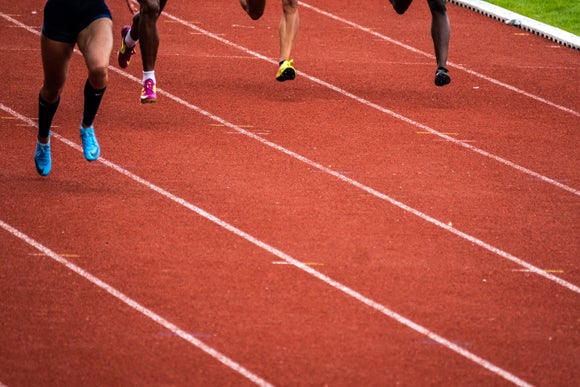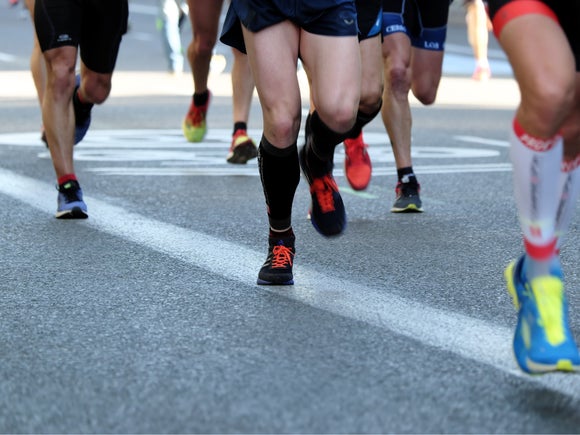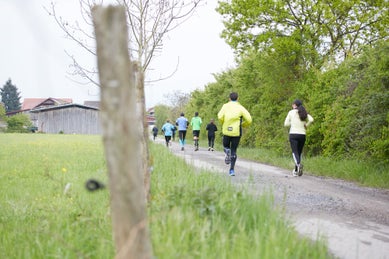Pro Coach's Series:
Base Training with the Fick Equation
Learn how competitive runners can use the Fick Equation in their base training to build their mileage, increase their running capacity, and improve their race-day performance.
Building the Equation

Maximum oxygen uptake, also known as VO2max, is the universally recognized standard of cardiovascular, pulmonary, and muscular aerobic fitness. It is defined as the maximum oxygen consumption that can be used by the body per minute, and ultimately, this represents an individual athlete's upper limit of aerobic metabolism. Therefore, raising an athlete's VO2max through the systematic implementation of training should consistently lead to performance gains in distance running. This is why nearly all top-level runners craft their training specifically toward raising their VO2max. Though, just knowing that increasing your VO2max can result in faster race times means very little if runners do not understand how to properly apply the different components of VO2max training, which brings us to the illustrious Fick Equation.
The Fick Equation is a mathematical estimation of an athlete's theoretical VO2max. Understanding the elements of the equation can help runners determine the specific types of workouts and paces that they should focus on to increase this variable.
The mathematical formula to determine a runner's VO2max is represented as follows:
VO2 max = Q(CaO2-CvO2)
Q is cardiac output
CaO2 = arterial oxygen content
CvO2 = venous oxygen content
More simply, to increase VO2max, runners must:
- Increase their cardiac output. That is, athletes must increase the amount of energy (oxygen) that is readily available for their working muscles.
- Increase their A-VO2 difference. In other words, athletes must (1) increase the delivery of available energy and (2) improve their efficiency of producing energy from available oxygen.
To continuously improve their performance, runners must seek ways to increase the supply of available energy to their muscles, improve the delivery of that available energy to the muscles, and increase the percentage of available energy that they can effectively use. In a runner's yearly training schedule, the base period is the ideal time to lay the groundwork for improvement in these areas.
Running Physiology 101

As you breathe, oxygen-rich air enters the lungs and fills the organ's air sacs before passing into the bloodstream, where oxygen then binds with the hemoglobin in our red blood cells to transport oxygen-rich blood throughout the body. The oxygen then branches off into capillaries surrounding the working muscles before being passed through to the muscles. Only then can it be utilized to produce energy.
Increasing the Amount of Energy Available to Working Muscles
Oxygen is the body's primary source of energy, as it helps convert carbohydrates and lipids into usable energy for our muscles. Therefore, increasing the amount of energy (oxygen) available to the muscular system is the number one incentive for growing a runner's VO2max. At a fundamental level, the more oxygen available in a runner's bloodstream, then the greater the potential for improved running performance.
Two primary factors can positively influence the amount of oxygen available in the bloodstream, including:
- The amount of blood pumped by the heart.
- The amount of available hemoglobin within the blood.
Cardiac Output = Max Heart Rate x Stroke Volume
Cardiac output is the total volume of blood that can be pumped by the heart, and it is the primary component of the body's oxygen supply chain. If an athlete's heart can pump a higher volume of blood, then an increased amount of oxygen will be made available to the working muscles, resulting in a greater potential for improved running performances.
As the mathematical formula shows, cardiac output can be increased by raising an athlete's max heart rate or by improving the stroke volume of the athlete's heart. Maximum heart rate represents the total number of heartbeats an athlete can produce per minute. Unfortunately, this variable is limited by one's genetics, so no matter how hard coaches may try, maximum heart rate is not a component that can be improved through training. Stroke volume on the other hand, which is the total amount of blood that an athlete's heart can pump per beat, is a factor that can be greatly improved with proper conditioning. If an athlete has a higher stroke volume, then an increased amount of oxygen can be made available to their working muscles, which can then lead to a potential increase in the athlete's overall work capacity. Enhancing stroke volume has the greatest potential for improving an athlete's running performance, and the development of this area should not be overlooked in an athlete's training plan.
Increasing the Amount of Available Hemoglobin
When evaluating the level of oxygen available in the bloodstream, it is also important to look at the composition of the blood itself. More specifically, it is necessary to examine the amount of hemoglobin present within the red blood cells.
If an athlete has low hemoglobin levels, then less oxygen will be readily available to transport to their working muscles. Sadly, when hemoglobin levels are really low, an athlete can become anemic, which will undoubtedly lead to decreased athletic performance, as well as a host of potential health complications if left unchecked.
So how does one raise their hemoglobin levels and avoid these potentially nasty complications? Living in areas at higher altitudes for extended periods can help tremendously, but sadly, living at altitude is not an option for every athlete. One area that all runners can control, relatively speaking, regardless of where they live, is their diet.
While training, athletes should establish a diet that emphasizes adequate iron intake, as well as consuming foods that will help the body absorb iron. This will not only support healthy performance development, but it will effectively fight off anemia as well. Base training is the perfect time for an athlete to establish a sound nutrition routine, and there is no better way to support your training.
Efficiency of Oxygen Usage

Unfortunately, performance will not solely improve as a result of having a large amount of oxygen available in the body. Improving the effectiveness of the oxygen delivery to the muscles, and increasing the efficiency at which muscles use that oxygen, are crucial when trying to improve an athlete's work capacity. Improving these key areas are critical for an athlete trying to obtain faster race times.
The three primary areas to address when trying to improve energy utilization and oxygen delivery are:
- Increasing the number and size of mitochondria
- Increasing aerobic enzyme activity
- Increasing the capillary network surrounding working muscles
While pursuing the improvement of the body's ability to utilize available oxygen, enhancing the muscle fibers' ability to use a higher percentage of available oxygen is a priority. Mitochondria are the aerobic powerhouses of cells, and they are specialists in the production of energy. They produce ATP (adenosine triphosphate), which is the molecule responsible for carrying all of the chemical energy needed to fuel the body. So by increasing the number and size of a cell's mitochondria and growing the cell's overall aerobic enzyme activity, muscles can improve the efficiency with which they utilize oxygen. Additionally, improving the effective delivery of oxygen to working muscles via the increase of the quantity and size of the capillaries can result in a net increase in that athlete's potential, as capillaries directly supply muscles with oxygen.
Training to Improve Efficiency of Energy Usage
To improve the body's ability to effectively use available oxygen, we must develop the number and the size of mitochondria, increase aerobic enzyme activity, and grow the capillary network around the working muscles This can be accomplished by repetitively completing sustained runs at 70-90% of an athlete's VO2max. These runs have been shown to increase mitochondria (size and quantity) and enzyme activity, and also increase the number and density of the capillaries surrounding the working muscles. These together increase the total volume of available oxygen in the body.
Performing sustained runs at 70-90% VO2max season after season promotes greater adaptation of the muscles, and improvements in this area will increase an athlete's ability to run for longer periods regardless of intensity. Ultimately, this will produce faster race times and will improve finishing kicks at the end of races even without requiring any improvements in a runner's overall leg speed.
| 5k Race Pace | 70-90% Training Pace |
| 15:00 | 5:30-7:00 min/mile |
| 17:00 | 6:00-7:45 min/mile |
| 19:00 | 6:30-8:30 min/mile |
As the above paces indicate, the level of effort is neither easy or all-out race speed. Rather, training runs that focus on improving the efficiency of a runner's energy usage are run at a strong, controlled pace over relatively long durations. That being said, during base training, these runs should be performed in a more relaxed fashion, staying within the 70-75% effort range. Then, as athletes mature and are better able to tolerate more stress, runs should be performed in the 80-90% effort range. Again, the most important factor is that these runs are executed in a strong, controlled nature over an extended period.
Examples include:
- An easy to moderate-effort run for 90-120 min at 70-75% of 5k pace
- Progressive run starting easy, making each mile faster, and then ending with 90% effort final mile
- 60-90 min hilly run, working the uphills at a strong effort and running the final 40-50 minutes at 75-80%.
- 20-30 min run at 90% effort (tempo run)
Over the years, there have been countless athletes with extremely high VO2max capabilities, but come race day, their times were relatively lackluster. This is likely because their body's ability to utilize available oxygen was low, which was probably the result of not consistently running extended lengths of time at paces that fall within the 70-90% effort range of their current 5k race pace. Ultimately, these runs play an enormous role in determining how fast an athlete can race in distance events.
Running copious amounts of mileage over a multitude of seasons within 70-90% of the 5k pace range will result in an increased ability to utilize available energy, enabling athletes to complete runs at a greater percentage of their VO2max for longer durations. This will result in faster race times regardless of the event's distance, including even sprints.
Applying The Fick to Your Training

For years, short, fast intervals have been a consistent element in nearly every top distance runner's training schedule. Whether the athlete is a middle-distance, long-distance, or marathon runner, the world's top distance athletes regularly incorporate short interval runs at 200m, 300m, and 400m into their annual training schedule. With this in mind, if an athlete is serious about improving as a competitive distance runner, then there is little question that they should incorporate short-distance interval runs into their training schedule throughout the year.
It is also important to note that these intervals do not need to be all-out efforts, and in fact, all-out efforts are counter-productive during the base training phase. It is more beneficial to do a larger number of reps at a hard controlled effort versus a smaller number of reps performed out of control. A 1500-3k hard effort will elicit the greatest benefit.
Intervals performed at a 5k pace will also produce notable performance gains and are much more appropriate for those coming off an injury or extended breaks (i.e. Masters). Short interval training runs should be programmed at least every other week and ideally throughout the majority of the year. This schedule is the most conducive for promoting improvement in an athlete's stroke volume.
Examples include:
- 40-60 min easy + 8 x 200m at 3k effort w/ 200m recovery jog interval
- 20-30 min easy + 9 x 250m hill reps at 3k effort w/ jog down recoveries + 10-15 min
- 30-40 min + 8 x 300 on grass at 1500-3k effort w/ easy 300m jog + 10-15 min
- 6-8 mile run on rolling hills. Surge uphill at XC/5k race effort
- 15-20 min + 30 sec on/60 sec off + 15-20 min (Masters or return from injury option)
Basic Outline
Every training day should have a purpose, and the chart above should help keep your paces within the intended range so that the system we are looking to train that day is being addressed. Running significantly faster or slower than the pace outlined for the day will work a different system, which is not ideal at this stage of training. Base training is about setting the groundwork for future success.
It is crucial to stick to the paces outlined above and base them on your CURRENT fitness, not your PR, and continue to train in this fashion until you have a recent race result to indicate your fitness level. By using race results, you ensure exactly where your body's fitness level is at and can plan your training paces accordingly. It is much better to train conservatively at this stage in terms of paces.
| % Effort | Type of Run |
| 70% or less (VERY EASY) | AM Runs, Easy & Recovery Runs |
| 70-75% (EASY TO MODERATE) | Encapsulates the majority of your weekly runs; includes your weekend long run |
| 75-80% (STRONG) | Mid Week Long Run. Last 40-50 min at this pace |
| 80-85% (MARATHON PACE) | 30-40 min Tempo Run |
| 85-90% (TEMPO) | 20-30 min Fast Tempo Run |
| 90-95% (10K Pace) | 3-5 min Long Interval Runs |
| 95-100% (5K Pace) | 2-3 min Medium Interval Runs |
| 100-105% (3K Pace) | 30 sec - 1 min Short Interval Runs |
Conclusion

The summer months are the ideal time to lay the groundwork for future success. The key components are: a high volume of weekly mileage, the addition of regularly scheduled short intervals, and several runs in the 70-90% of 5k pace range.
These types of workouts perform essential functions in the continued improvement of race times. Short intervals increase the stroke volume of the athlete to circulate more oxygen toward working muscles, while 70-90% efforts improve the athlete's ability to utilize this added oxygen. The adaptations created by this training form the necessary groundwork for continued improvement in distance running performances over time.


